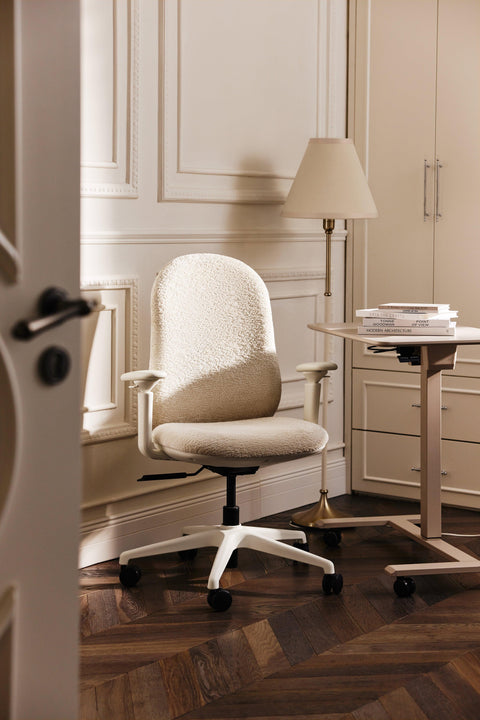Are Standing Desks Worth It?
In recent years, standing desks have become increasingly popular in offices and homes alike. Many people now know that sitting too long can be bad for their health. So, a common question is: are standing desks a good choice?
This article will look at the benefits of standing desks. It will discuss how they can affect your work-life balance and if they are worth the money for you.
Understanding Standing Desks
Before diving into the benefits, it's important to understand what a standing desk is. Simply put, a standing desk allows you to stand up while working. These desks can be adjusted to different heights, enabling you to alternate between sitting and standing throughout the day.
Types of Standing Desks
There are various types of standing desks available on the market, including:
-
Fixed-height desks: These are non-adjustable desks set at a standing height. They offer simplicity and often come at a lower price point, but lack versatility.
-
Adjustable desks: These allow you to change the height, making it easy to switch between sitting and standing. This type provides flexibility and can be beneficial for multi-user environments.
-
Desk converters: These sit on top of a regular desk and can be adjusted to create a standing workspace. They are a cost-effective solution for those looking to test the waters before committing to a full standing desk.
Highlight: Ripple Standing Desk from TopJob
If you want a desk that does more than just change height, the Ripple Standing Desk is a great choice. It combines movement, style, and useful features. It's ideal for users who care about wellness and workspace aesthetics. Key features include:
-
Subtle motion design that encourages light movement throughout the day to promote better circulation and focus.
-
Sleek, elegant silhouette that blends into any space — from minimalist home offices to modern corporate environments.
-
Integrated cable management that keeps cords hidden and your setup clutter-free.
-
Thoughtful ergonomics and versatility, supporting both standing and sitting routines seamlessly.
Ripple isn’t just a desk — it’s an investment in daily well-being and elevated workspace design.
Mechanisms of Adjustment
Understanding how standing desks adjust can help you choose the right model.
-
Manual adjustment: Some desks require manual cranking or lifting to change height. Although cost-effective, they might not be as convenient for frequent adjustments.
-
Electric adjustment: These desks use motors to change height at the push of a button. They offer ease of use but can be more expensive due to the technology involved.
-
Hydraulic or pneumatic adjustment: These desks use a gas lift system. This makes it easy to raise and lower them. They can also be quieter than electric desks.
Space Considerations
When choosing a standing desk, consider the space it will occupy.
-
Footprint: Measure the available space to ensure the desk fits comfortably without overcrowding the room.
-
Workspace area: Consider the surface area needed to accommodate your equipment, such as monitors, keyboards, and other accessories.
-
Storage options: Some standing desks come with built-in storage, which can be beneficial in maintaining an organized workspace.
For those mindful of aesthetics, the Ripple Standing Desk offers a sleek profile with cable management built in — keeping your workspace clean without sacrificing design.
Benefits of Standing Desks
Standing desks offer several benefits that can positively impact your health and productivity.
Improved Posture and Reduced Back Pain
One of the primary benefits of standing desks is improved posture. Sitting for long periods can lead to poor posture and back pain. Standing while working encourages a more natural posture, reducing the strain on your back and neck.
-
Spinal alignment: Standing desks promote better spinal alignment, which can alleviate stress on the spine and reduce discomfort.
-
Muscle engagement: When standing, your core and leg muscles are more engaged, helping to maintain posture and prevent slouching.
-
Neck and shoulder relief: By keeping your monitor at eye level, standing desks help reduce neck and shoulder strain.
Increased Energy and Focus
Standing desks can also boost your energy levels and improve focus. When you stand, your blood circulates more efficiently, delivering oxygen and nutrients to your brain. This can help you feel more alert and engaged, leading to increased productivity.
-
Enhanced circulation: Improved blood flow can reduce feelings of fatigue and help maintain energy levels throughout the day.
-
Mental clarity: Standing can sharpen focus, making it easier to concentrate on tasks and stay productive.
-
Mood enhancement: Some users say they feel happier and more motivated when they use a standing desk. This helps create a better work environment.
Enhanced Work-Life Balance
By promoting better posture and increased energy, standing desks can contribute to a healthier work-life balance. When you feel better physically, you're more likely to enjoy your time outside of work, leading to a more balanced lifestyle.
-
Reduced stress: Physical well-being can lead to decreased stress levels, allowing for more enjoyment in personal activities.
-
Increased flexibility: Switching between sitting and standing can help adjust to different work needs and times.
-
Encouragement of active breaks: Standing desks can encourage more movement and breaks. This helps create a balanced lifestyle.
Calorie Burning
While standing isn't a substitute for exercise, it can help you burn more calories than sitting. Standing burns about 50 more calories per hour compared to sitting. Over time, this can contribute to weight management and improved overall health.
-
Weight management: Regular standing can be a part of an active lifestyle, aiding in maintaining a healthy weight.
-
Metabolic benefits: Standing may improve metabolic rates, potentially reducing the risk of obesity-related health issues.
-
Supporting physical activity: Standing can help you move more during the day. It adds to your other workouts.
Potential Drawbacks of Standing Desks
While standing desks offer numerous benefits, it's important to consider potential drawbacks.
Fatigue and Discomfort
Standing for long periods can lead to fatigue and discomfort in your legs and feet. To minimize these effects, it's essential to alternate between sitting and standing throughout the day.
-
Leg strain: Prolonged standing can cause discomfort in the legs and joints, necessitating regular movement or stretching.
-
Foot fatigue: Without proper support, standing can lead to tired and achy feet, emphasizing the need for appropriate footwear.
-
Varicose veins risk: Standing for too long without breaks can increase the risk of developing varicose veins.
Cost
Standing desks can be more expensive than traditional desks, which might be a consideration for those on a budget. However, the long-term health benefits may outweigh the initial cost.
-
Budget considerations: Assess the initial investment against potential health benefits and productivity gains.
-
Long-term savings: Consider the potential reduction in healthcare costs due to improved posture and reduced pain.
-
Quality versus price: Check the desk's quality and features. Make sure it fits your needs and is worth the price.
Space and Setup Challenges
Introducing a standing desk into your workspace may pose spatial and setup challenges.
-
Workspace reorganization: Transitioning to a standing desk may require rearranging your workspace to accommodate the new setup.
-
Technical adjustments: Ensure that all necessary equipment, such as cables and peripherals, can accommodate the desk's height changes.
-
Aesthetic considerations: Think about how the desk looks in your workspace. Does it match your style?
Tips for Using a Standing Desk
To maximize the benefits of a standing desk, consider the following tips:
Alternate Between Sitting and Standing
To avoid fatigue, it's important to switch between sitting and standing throughout the day. Experts recommend standing for about 15-30 minutes every hour.
-
Scheduled transitions: Set reminders or use apps to prompt you to change positions regularly.
-
Balance activities: Stand when doing tasks that need focus or creativity. Sit for tasks that involve a lot of reading or writing.
-
Listen to your body: Adjust your standing and sitting intervals based on personal comfort and energy levels.
Invest in a Good Mat
An anti-fatigue mat can help cushion and support your feet when you stand. This makes it easier to stand for a long time.
-
Material choice: Look for mats made from high-quality materials that offer durability and comfort.
-
Size considerations: Ensure the mat is large enough to accommodate your stance and allow for movement.
-
Cleaning and maintenance: Choose a mat that is easy to clean and maintain to ensure longevity.
Maintain Proper Ergonomics
Ensure that your standing desk is set up ergonomically to prevent strain on your body. Keep your monitor at eye level and your keyboard at a comfortable height to maintain a neutral wrist position.
-
Desk height adjustment: Make sure the desk is adjusted to a height that allows your arms to rest naturally.
-
Monitor positioning: Place your monitor so the top of the screen is at eye level or a little lower. This will help prevent neck pain.
-
Keyboard and mouse placement: Keep these tools at elbow height to reduce wrist and shoulder strain.
Wear Comfortable Shoes
Wearing supportive and comfortable shoes can help reduce discomfort while standing. Avoid high heels or shoes with inadequate support.
-
Shoe selection: Opt for shoes with good arch support and cushioning to alleviate foot fatigue.
-
Rotation of footwear: Consider rotating different pairs of supportive shoes throughout the week.
-
Insoles and inserts: Use insoles or orthotic inserts to enhance comfort and support, especially if standing for extended periods.
Are Standing Desks Right for You?
Ultimately, whether a standing desk is worth it depends on your personal preferences and work habits. If you want to stand better, feel more energetic, and balance work and life, a standing desk might be a good option.
Evaluating Your Needs
Consider how much time you spend at your desk and any existing health concerns. If you experience back pain or fatigue from sitting, a standing desk might provide relief.
-
Work environment: Assess the nature of your work and whether it allows for standing desk use.
-
Personal health goals: Consider whether a standing desk aligns with your health and lifestyle objectives.
-
Physical limitations: Evaluate any physical conditions that might be affected by prolonged standing.
Trying Before Buying
If you're unsure whether a standing desk is right for you, consider trying one out before making a purchase. Many companies offer trial periods, allowing you to test the desk in your workspace.
-
Trial options: Look for retailers that offer flexible return policies or trial periods.
-
Temporary solutions: Consider using a desk converter as a low-commitment way to experiment with standing.
-
Feedback and reviews: Research user reviews and seek feedback from others who have used standing desks to inform your decision.
Considering Hybrid Solutions
For those undecided, hybrid solutions may offer a balanced approach.
-
Sit-stand desks: These combine traditional and standing desk features, offering the flexibility to switch between modes.
-
Mobile workstations: Portable desks or carts can provide the benefits of standing while allowing for movement and flexibility.
-
Collaborative spaces: Look for shared workspaces that have standing desks. This way, you can try them out and enjoy the benefits without committing to one right away.
Conclusion
Standing desks have many benefits. They can help you sit better, feel more energetic, and balance work and life better. While there are some drawbacks to consider, many people find that the advantages outweigh the disadvantages.
You can improve your standing desk experience by switching between sitting and standing. Use good posture and choose the right accessories. Whether a standing desk is worth it depends on your needs and likes. For many people, it is a good investment for their health and work.
-
Personalized approach: Tailor your standing desk use to fit your unique needs and work habits.
-
Informed decision-making: Weigh the pros and cons based on comprehensive research and personal trials.
-
Commitment to health: Embrace the standing desk as part of a broader commitment to improve well-being and productivity.



